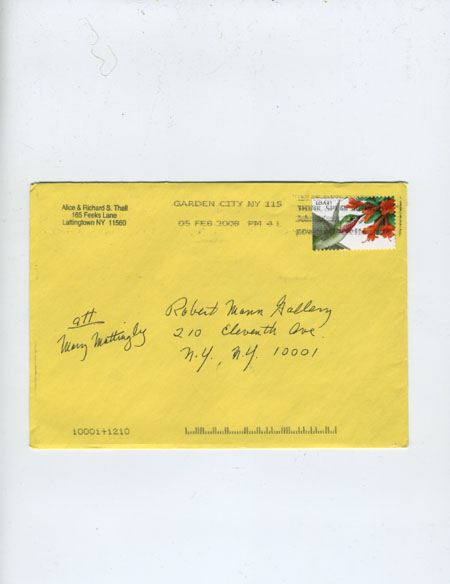![]() body | color | collections | commodity | cube | document | fabric | fetish | gender | glass | home | identity | living | machine | metal | minimal | mobility | narrative | olfactory | organic |
body | color | collections | commodity | cube | document | fabric | fetish | gender | glass | home | identity | living | machine | metal | minimal | mobility | narrative | olfactory | organic |
![]() pain | paper | plastic | plugs | power | protective | rectangular | ritual | round | sound | souvenir | spiritual | style | text-based | time | tool | touch | uniform | value | visual | warm | wood
pain | paper | plastic | plugs | power | protective | rectangular | ritual | round | sound | souvenir | spiritual | style | text-based | time | tool | touch | uniform | value | visual | warm | wood
| Stamped and Addressed Yellow Envelope | |||
Narrative: I received this envelope in 2008, with a "Get Well Soon" card inside. The points of most ballpoint pens are made out of brass, which is an alloy of copper and zinc. Oleic acid, castor oil, or a sulfonamide plasticizer are also used. The markers bodies, caps, and plugs are formed from plastic resin. The marker reservoirs are formed from polyester. Powder and water are used to form the felt writing tip. In addition, markers require ink, and the pigments and synthetic substances used to make it. To make the body of the marker, plastic resin is injection-molded into a marker body. Injection molding involves heating plastic resin, into a molten state and forcing (injecting) it into a mold of the desired shape, then allowing it to cool and harden. Marker caps and plugs are formed in the same manner as the barrel. The nib, or tip, of the marker is made from powder mixed with water, molded, and baked into its pointed or flat form. Using one machine for all the following functions, an assembler then places a polyester cylinder inside the marker barrel to form a reservoir for the ink, fills the reservoir with ink, and inserts the nib at the bottom and the cap at the top. The markers are then placed into color assortment and packaged for retail marketing. Rolls of paper, typically weighing 220 lb are either cut before they enter the automated machine that makes the envelopes, or fed directly into the machine from the roll. Once cut, the sheets are stacked and cut into blanks. A blank has the shape of an envelope with its flaps opened and laid flat. Shaped like diamonds and cut from the sheets in such a way as to minimize waste. The glue applied to the flap that is sealed by the consumer is usually a gum. A typical natural gum is gum arabic, derived from a substance produced by the acacia tree. Synthetic gums are often derived from dextrans, which are produced by the fermentation of sugar. The glue that holds the rest of the envelope must be stronger and more permanent. This glue is often derived from starches, which are obtained from corn, wheat, potatoes, rice, and other plants. The completed envelopes are filled in cardboard boxes and shipped to retailers. Sticker postage stamps, ink-based stamps, and airmail stickers still need to be accounted for here. Text was typed on a typewriter and pencil drawn. Graphite combined with clay and wax or other chemicals make up the center of the pencil. The wood used to manufacture pencils must be able to withstand repeated sharpening and cut easily without splintering. Most pencils are made from California cedar. Some pencils have erasers, which are held on with a ferrule, a metal case that is either glued or held on with metal prongs. The erasers themselves consist of pumice and rubber. |
 |
||
![]()
